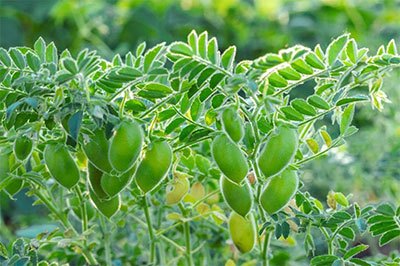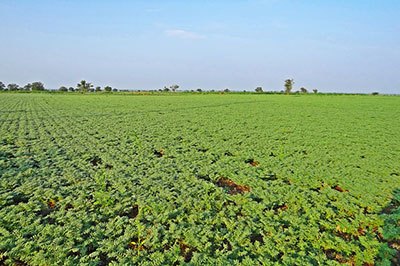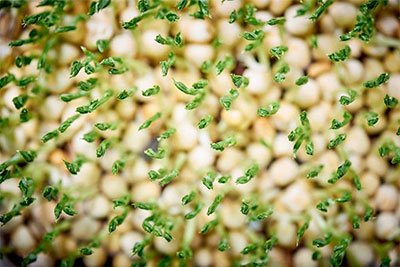My family loves warm chickpea soup for dinner, especially on cold nights. Buying garbanzo beans was what we usually did. When I finally decided to learn how to grow garbanzo beans in my own backyard, there was no turning back.
The process of growing garbanzo beans is not that hard as it does not require tremendous care, unlike other plants, so you can definitely do this too.
Garbanzo beans, also known as chickpeas, are one of the tastiest sources of protein, fiber, Vitamin B3, potassium, and Omega 6, among many other nutrients and vitamins.
Table of Contents
Planting the garbanzo beans
1. Understand garbanzo beans before you begin

Garbanzo beans are annual bushy plants producing tender legumes. Their leaves are dark green, and their oblong pods are about one inch in length containing one to two large, creamy-colored seeds that resemble peas.
They also grow white or violet-colored flowers which are dependent on what variety they are.
Garbanzo beans take a long growing season that may require up to 100 days starting from the date that they were sowed.
As you will be needing more time in growing garbanzo beans, you need to start ahead of the season. It is best to begin sowing earlier in the spring or before the last frost ends.
2. Handling the seeds
You have to be gentle with the seeds as they are sensitive to temperature. Do not try to plant them in the cold ground.
You can proceed with the sowing indoors four to six weeks before the expected final frost by sowing in peat, or you can use any temporary pots prior to planting it out when it is ready.
The garbanzo beans are ready to be transplanted out in your garden when it is about four to five inches tall as soon as the final frost has ended.
Before transplanting, you can gradually expose the plants to the outside environment to achieve better results. This process is called “hardening“.
However, if you would like to plant the seeds outdoors directly, do this around one to two weeks before the last expected frost. As it will get colder at night, make sure that you cover the seeds with old sheets as their insulators.
3. Laying the seeds

You will achieve larger yields if you are growing garbanzo beans in subtropical regions. Garbanzo plants usually grow up to 20 inches or shorter.
In placing the plants in the soil, make sure that they are six inches apart from each other, with around 18-24 inches in between rows.
If you are planting the seeds in a pot, fill the pot with a little soil, then proceed in planting one to two seeds in it.
Keep in mind that the seeds must be one to two inches deep into the soil. When you are starting, it is okay to plant a maximum of two seeds per pot.
However, when they begin sprouting, you have to decrease them to one per pot. In doing this, choose the weaker seedling and cut it away from the soil level, making sure that you avoid digging as this will damage the roots.
4. Watering the seedlings
Your seedlings will usually sprout within two weeks that they were sowed.
Garbanzo beans have a shallow root system, so it is best to water them appropriately. You have to make sure that your soil is moist but never drenched by watering your seedling on a daily basis.
When the temperature is warmer, water your seedlings twice a day. Your pots should also receive enough sunlight. You can place them outdoors or nearby your windows for direct sun exposure.
Too much water can cause the seeds to crack, so water them in appropriate amounts. Never soak the seeds prior to sowing.
Transplanting garbanzo seedlings
1. Best type of soil

The best soil to transplant your seedlings to is loose, preferably organic, well-drained soil. You can also add compost to your pots for advanced produce.
Do not plant your seedlings in high-nitrogen-containing soils, and similarly, do not use nitrogen-rich fertilizers. High nitrogen levels will make your plants’ leaves bushy but will also result in less productivity.
Garbanzo beans will naturally have their needed nitrogen produced through their mutual exchange with soil microorganisms called nitrogen-fixing bacteria.
2. Sunlight
Growing garbanzo beans require lots of sunlight, so you must choose a location where your plants will be provided with at least a six-hour direct sunlight exposure.
As sunlight yields more growth, planting your seedlings under shady locations would be okay, but this will give you smaller produce.
Maintaining garbanzo beans
1. Dealing with pests
During hot weather, garbanzo beans will excrete a reddish dew on their leaves containing malic acid. This is a skin irritant, so you need to wear gloves when harvesting.
Malic acid will prevent most pests to damage the plants. However, mice and birds can still attack it.
2. Design
You will need to do continuous weeding in the first few weeks until the plants are able to stop the weeds altogether and form a dense protective cover. At this point, only perennial weeds can prevail.
Your soil can also encourage the growth of foot rots and molds during rainy seasons and cold weather. Include garbanzo beans in normal legume rotations to prevent damaging the plant.
Harvesting

Garbanzo beans can be harvested as soon as the peas inside the pods are large enough to be eaten. You can wait until the pods are ripe enough; however, because of mice eating the seeds, this is not advisable.
Harvest time can last up to several months and is only interrupted as soon as hard frosts start. You will be able to harvest one to three peas from each pod.
You need to observe extra caution in harvesting due to the malic acid as well as the spikes in the pod ends that can cause injury when not handled properly.
Final thought
I had several failed attempts at growing garbanzo beans when I was still starting.
I have learned these tricks through the years, and they have yielded me good results and sumptuous chickpea soups as well. I hope these tips gave you enough confidence to try this as well in your own backyards.
Leave a comment below if you need more clarification, and I will be happy to walk you through it. If you like this article, don’t forget to like it and share it with your friends.

Thank you for the article. I tried once to grow Garbonzo, but doing so like I grow kidney beans, corn etc. We don’t have a long enough growing season or I started too late. Would you suggest just starting in pots (what size?) in the green house?
Author’s experience is evident. And the article is so well composed : much information given succinctly — my favorite style of composition.
Today I bought garbanzos in fresh green pods. In market’s produce shelf (I do not remember whether cooled). Suitable for sprouting? If so, then immediately?